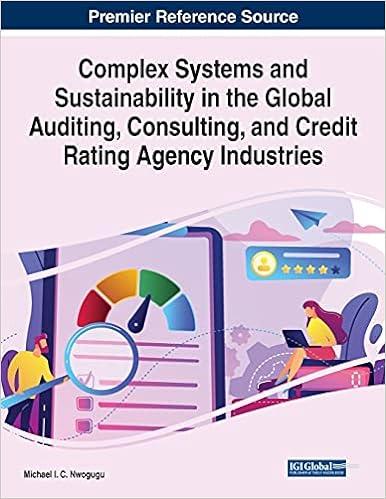Question
Land trusts, also known as conservancies, are not-for-profit organizations dedicated to protecting wildlife habitat and natural lands by acquiring ownership rights and transfer of development
Land trusts, also known as conservancies, are not-for-profit organizations dedicated to protecting wildlife habitat and natural lands by acquiring ownership rights and transfer of development rights (conservation easements) either thru donation or purchase. This series of cases follows a small land trust through the process of budgeting. Case I requires students to develop and analyze an annual line-item budget and translate that budget, and additional information, into a quarterly cash budget. Case II requires students to convert the line-item budget into a functional budget. Further information is employed by students to create a flexible budget. Actual numbers have been obscured while remaining true to the problems faced by the organization.
Chippewa Watershed Conservancy: Not-for-profit Budgeting
Case I: Line-item and Cash Budgets
INTRODUCTION
The Chippewa Watershed Conservancy (CWC) is a small (one staff person) land trust operating in the Mt. Pleasant, Michigan area. Founded in 1985, the CWC has protected 3,494 acres in the Central Michigan area and ranks in the top 10 out of more than 40 conservancies in Michigan in acreage protected. They can be found on the web at www.chippewawatershedconservancy.org.
Brief History
The CWC operated on a volunteer basis from 1985 until 2004. During that time period volunteers performed all management functions and succeeded in protecting more than four square miles of wildlife habitat in five counties. However, it became apparent that due to the increasing number of protected parcels and the evolution of legal requirements and management standards that the CWC needed professional leadership. In 2004 a part-time employee was hired. That position was increased over the next several years to a full-time Executive Director status. Over that time period management responsibilities were transferred from volunteers to the Executive Director. Members of the Board of Directors (BOD) continue to serve in a volunteer capacity; however, most of the management of the organization is now performed by the Executive Director. Some technical functions, such as legal review of conservation easements, annual audit, and some routine accounting are contracted out. Members of the BOD, and other volunteers, continue to help with membership, fundraising, stewardship, and new project evaluation.
The BOD is extremely concerned that the CWC be managed so that it is sustainable. The commitments of land trusts are, by their very nature, long-term (actually perpetual). Therefore, the CWC must ensure that they have a business plan and budget that will ensure their long-term survival.
The Current Situation
The Executive Director is formulating an Operating Budget recommendation for the next year. He has made a series of assumptions based on previous year performance and expectations about the coming year. He is particularly concerned about increased energy costs and a likely recession that may hold down contributions and foundation support. The CWC wants to budget for a 5% (of total expense) surplus to provide protection against unforeseen events.
Your role is to prepare the budget for the following (next) year based on the assumptions adopted by the Executive Director and the budget for the current year. You will also be asked to analyze the results of those budget assumptions.
Assumptions for NEXT budget year:
Revenue: Special events will increase by 30% due to a new event. Contributions will increase by 20% due to new membership drives. Grants will fall by half due to the end of a current grant. Interest income will be unchanged from the current year, but endowment income will be up 20% due to large endowment contributions in the current and previous years.
Expenses: Special events will increase by 30% due to an additional event while there will be a 20% increase in fundraising, newsletter, and postage expenses. The staff person has already been notified that he should not expect a raise. All other expenses, with the exception of payroll tax, which is proportional to wages, will increase by 10%.
Current Year Budget
Revenue: Timing:
Special Events $8,000. 1stqtr. 10%, 2ndquarter 60% and 3rdquarter 30%
Contributions $40,000. 1stqtr. 20%, 2ndqtr. 20%, 3rdqtr. 10%, 4thqtr. 50%
Grants $40,000. 4thquarter 100%
Endowment Income $5,000. 25% each quarter
Interest Income $1,600 interest on operating fund (1% prev. qtr. ending bal.)
Total Revenue $94,600.
Expenses:
Travel $4,000. 1stand 2ndquarters 20%, 3rdquarter 35%, 4thquarter 25%
Special Events $8,000. 1stquarter 20%, 2ndquarter 50%, 3rdquarter 30%
Conferences $2,000. 3rdquarter
Fundraising $6,000. 1stquarter 20%, 2ndquarter 30%, 4thquarter 50%
Insurance $4,000. 1stquarter
Newsletter $5,000. 25% each quarter
Postage $3,000. 25% each quarter
Professional Fees $5,000. 1stquarter 70% and 10% each remaining quarters
Publicity $3,000. 25% each quarter
Salary $38,000. 25% each quarter
Supplies $4,000. 25% each quarter
Payroll Taxes $3,800. 10% of Salaries and Wages each quarter
Telephone $1,200. 25% each quarter
Total Expense $87,000.
2) Prepare a quarterly cash budget for the next year. Assume all revenue and expenses occur on the last day of each quarter. Also assume a $40,000 beginning cash balance. Add 1% each quarter based on the beginning of quarter cash balance (.01 x beginning of quarter cash balance) as interest income. Re-calculate the Interest Income line item for the year.
a) Does the CWC have adequate cash reserves to get them thru the year?
b) How large (calculated both as a dollar amount and as a percent of annual expense) is the
lowest quarterly ending cash balance?
c) If they lack sufficient cash flow, what might they do to correct the problem?
d) Why did the Interest Income line item increase (decrease) from the budgeted amount?
Step by Step Solution
There are 3 Steps involved in it
Step: 1

Get Instant Access to Expert-Tailored Solutions
See step-by-step solutions with expert insights and AI powered tools for academic success
Step: 2

Step: 3

Ace Your Homework with AI
Get the answers you need in no time with our AI-driven, step-by-step assistance
Get Started


